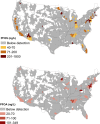Detection of Poly- and Perfluoroalkyl Substances (PFASs) in U.S. Drinking Water Linked to Industrial Sites, Military Fire Training Areas, and Wastewater Treatment Plants
- PMID: 27752509
- PMCID: PMC5062567
- DOI: 10.1021/acs.estlett.6b00260
Detection of Poly- and Perfluoroalkyl Substances (PFASs) in U.S. Drinking Water Linked to Industrial Sites, Military Fire Training Areas, and Wastewater Treatment Plants
Abstract
Drinking water contamination with poly- and perfluoroalkyl substances (PFASs) poses risks to the developmental, immune, metabolic, and endocrine health of consumers. We present a spatial analysis of 2013-2015 national drinking water PFAS concentrations from the U.S. Environmental Protection Agency's (US EPA) third Unregulated Contaminant Monitoring Rule (UCMR3) program. The number of industrial sites that manufacture or use these compounds, the number of military fire training areas, and the number of wastewater treatment plants are all significant predictors of PFAS detection frequencies and concentrations in public water supplies. Among samples with detectable PFAS levels, each additional military site within a watershed's eight-digit hydrologic unit is associated with a 20% increase in PFHxS, a 10% increase in both PFHpA and PFOA, and a 35% increase in PFOS. The number of civilian airports with personnel trained in the use of aqueous film-forming foams is significantly associated with the detection of PFASs above the minimal reporting level. We find drinking water supplies for 6 million U.S. residents exceed US EPA's lifetime health advisory (70 ng/L) for PFOS and PFOA. Lower analytical reporting limits and additional sampling of smaller utilities serving <10000 individuals and private wells would greatly assist in further identifying PFAS contamination sources.
Conflict of interest statement
The authors declare no competing financial interest.
Figures
Similar articles
-
Evaluation of a national data set for insights into sources, composition, and concentrations of per- and polyfluoroalkyl substances (PFASs) in U.S. drinking water.Environ Pollut. 2018 May;236:505-513. doi: 10.1016/j.envpol.2018.01.066. Environ Pollut. 2018. PMID: 29427949 Free PMC article.
-
Investigation into perfluoroalkyl substances (PFASs) in a cranberry bog: method development and sampling results.Food Addit Contam Part A Chem Anal Control Expo Risk Assess. 2017 Dec;34(12):2181-2189. doi: 10.1080/19440049.2017.1361046. Epub 2017 Sep 13. Food Addit Contam Part A Chem Anal Control Expo Risk Assess. 2017. PMID: 28901245
-
Occurrence of select perfluoroalkyl substances at U.S. Air Force aqueous film-forming foam release sites other than fire-training areas: Field-validation of critical fate and transport properties.Chemosphere. 2016 May;150:678-685. doi: 10.1016/j.chemosphere.2016.01.014. Epub 2016 Jan 16. Chemosphere. 2016. PMID: 26786021
-
A review of contamination of surface-, ground-, and drinking water in Sweden by perfluoroalkyl and polyfluoroalkyl substances (PFASs).Ambio. 2017 Apr;46(3):335-346. doi: 10.1007/s13280-016-0848-8. Epub 2016 Nov 14. Ambio. 2017. PMID: 27844420 Free PMC article. Review.
-
Differential toxicity between perfluorooctane sulfonate (PFOS) and perfluorooctanoic acid (PFOA).J Toxicol Sci. 2016;41(Special):SP27-SP36. doi: 10.2131/jts.41.SP27. J Toxicol Sci. 2016. PMID: 28003637 Review.
Cited by
-
Quantitative assessment of poly- and perfluoroalkyl substances (PFASs) in aqueous film forming foam (AFFF)-impacted soils: a comparison of analytical protocols.Anal Bioanal Chem. 2024 Oct 16. doi: 10.1007/s00216-024-05585-2. Online ahead of print. Anal Bioanal Chem. 2024. PMID: 39414643
-
Mapping Per- and Polyfluoroalkyl Substance Footprint from Cosmetics and Carpets across the Continental United States.ACS ES T Water. 2024 Aug 2;4(9):3882-3892. doi: 10.1021/acsestwater.4c00198. eCollection 2024 Sep 13. ACS ES T Water. 2024. PMID: 39296622
-
Carbon Adsorbent Properties Impact Hydrated Electron Activity and Perfluorocarboxylic Acid (PFCA) Destruction.ACS ES T Eng. 2024 Aug 2;4(9):2220-2233. doi: 10.1021/acsestengg.4c00211. eCollection 2024 Sep 13. ACS ES T Eng. 2024. PMID: 39296420 Free PMC article.
-
Exploring the Prospects and Challenges of Fluorine-Free Firefighting Foams (F3) as Alternatives to Aqueous Film-Forming Foams (AFFF): A Review.ACS Omega. 2024 Aug 28;9(36):37430-37444. doi: 10.1021/acsomega.4c03673. eCollection 2024 Sep 10. ACS Omega. 2024. PMID: 39281906 Free PMC article. Review.
-
Neurotoxic Effects of Mixtures of Perfluoroalkyl Substances (PFAS) at Environmental and Human Blood Concentrations.Environ Sci Technol. 2024 Sep 11;58(38):16774-84. doi: 10.1021/acs.est.4c06017. Online ahead of print. Environ Sci Technol. 2024. PMID: 39259824 Free PMC article.
References
-
- Kissa E.Fluorinated surfactants and repellents, 2nd ed.; CRC Press: Boca Raton, FL, 2001.
-
- Lewis R. C.; Johns L. E.; Meeker J. D. Serum Biomarkers of Exposure to Perfluoroalkyl Substances in Relation to Serum Testosterone and Measures of Thyroid Function among Adults and Adolescents from NHANES 2011–2012. Int. J. Environ. Res. Public Health 2015, 12 (6), 6098–6114. 10.3390/ijerph120606098. - DOI - PMC - PubMed
-
- Fourth National Report on Human Exposure to Environmental Chemicals; Centers for Disease Control and Prevention: Atlanta, 2015.
Grants and funding
LinkOut - more resources
Full Text Sources
Other Literature Sources
Research Materials
Miscellaneous


